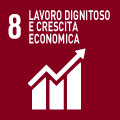- Docente: Paola Subacchi
- Crediti formativi: 8
- SSD: SECS-P/01
- Lingua di insegnamento: Inglese
- Modalità didattica: Convenzionale - Lezioni in presenza
- Campus: Bologna
- Corso: Laurea Magistrale in International Relations (cod. 9084)
-
dal 18/02/2025 al 08/05/2025
Conoscenze e abilità da conseguire
The course offers a series of advanced analytical tools to understand European economic development as well as economic policies related to EU integration and enlargement, their political and economic prerequisites and their impact on member states. At the end of the course, students will be able to use models of political economy, institutional economics and economic analysis in order to critically evaluate the process of economic integration in Europe in the trade, monetary and financial areas.
Contenuti
This course explores the economic integration of the European Union (EU) and its role in the global economy. Students will learn some basic economic concepts and theory, before gaining a solid understanding of the economic dynamics between EU member states as well as between the EU and the rest of the world.
The course is divided into three main sections.
The first section provides students with the necessary foundations (concepts, theories and history) to understand the integration of the EU and trade globalisation. It covers two main topics: the microeconomics of European integration and the economics of preferential liberalisation.
Case study 1: The first case study examines how the economics of preferential liberalisation works in practice. Starting with a discussion on the different levels of economic integration within the EU, we will look at the relationship of the UK with the EU as a result of Brexit. Students will gain an understanding of the role that the UK played in shaping the EU as well as the tensions that ultimately resulted in the UK's decision to leave the EU. We will also explore the Trade and Cooperation Agreement which now governs the trade relations between the EU and the UK.
The second section focuses on the EU’s trade policy, both at the multilateral and bilateral level – from WTO rules to bilateral trade and investment agreements – and looks at the internal EU trade policy formulation and the external negotiating dynamics. For this we will explore how the EU’s trade policy is articulated and implemented. This section also considers the role of trade policy as a tool to engage the trade partners with the EU’s goals for economic development and promote good standards (environmental, food, human rights etc.).
Case study 2: The second case study takes a detailed look at the EU-Canada Comprehensive Economic and Trade Agreement (CETA) to discuss the use of trade policy for non-trade purposes. The focus is on CETA’s chapters on sustainable development and the cooperation between the EU and Canada on trade-related environmental and labour rights issues for the implementation of all ratified Multilateral Environmental Agreements and the fundamental conventions of the International Labour Organisation.
The third section looks at the logic of economic growth within the context of Europe’s single market as well as in relation to external partners. We will discuss how economic integration has contributed significantly to economic growth. We will also address the EU’s future prospects for growth and explore challenges such as the demographic transition, technology and innovation, and climate change.
Case study 3: The third case study revolves around the Next Generation EU (NGEU), the EUR 750 bn facility to support recovery from the COVID-19 pandemic and the EU’s long-term priorities across different policy areas, including the green and digital transitions.
Please note that this course is designed specifically for students at the master's level and assumes a foundational knowledge in the subject area that undergraduates may not yet possess. Undergraduate students might find the content challenging without having completed essential prerequisite coursework or gained relevant experience.
Testi/Bibliografia
Richard Baldwin and Charles Wyplosz, The Economics of European Integration (London: McGraw Hill Education, sixth edition, 2019), chapters 1-7.
Mario Draghi, The future of European competitiveness. Part A: A competitiveness strategy for Europe, September 2024,
https://commission.europa.eu/topics/eu-competitiveness/draghi-report_en
Additional required readings and suggested further readings will be provided during the course. Other materials used in class will be made available online afterward.
The reading list varies each year and includes a range of sources, such as policy briefs, academic papers, op-eds, and podcasts.
Metodi didattici
Learning will revolve around lectures and classwork, suggested reading material and case studies. For the case studies, students will be required to familiarise themselves with a short reading in advance so that they can contribute the discussion, share their ideas and improve their analytical ability
At the end of the course students will be able to critically evaluate current policy measures and contribute to the debate on Europe’s economic future against the changing dynamics of the world economy.
Attendance at all lectures is strongly recommended, especially for the case study sessions when students will have more opportunity to share their ideas and advance their analytic ability.
Modalità di verifica e valutazione dell'apprendimento
The assessment is scheduled during the main exam periods (June-July, September and January-February), and consists of a written exam (25%) and an essay (75%). Students must submit their essay at least one week prior to the written exam.
1. Exam
The written exam requires students to answer some specific questions on the course's material. Students will have 60 minutes to complete the exam.
The written exam accounts for 25% of the final mark. Students must pass the written exam to pass the overall exam.
2. Essay
There is no set question for the course essay. Students will be required to pick a topic of their choice that is aligned with the remit of the course and submit an essay no longer than 3,000 words (excluding notes and references).
The objective is to produce a brief that is informative and analytical, but also concise and focused. Building on your knowledge of the course material and even expanding it, in your essay you need to show your analytical skills and the use of solid evidence.
The essay accounts for 75% of the final mark and needs to be submitted at least one week before the chosen exam date.
Strumenti a supporto della didattica
Presentations and reading material will be made available online.
Course Schedule
The course is organised into three blocks, separated by two revision breaks.
Classes will begin on Tuesday, February 18th, at 13.00, instead of Tuesday, February 10th.
The last lesson of the first block will be held on Friday, March 7th, at 9.00.
Classes will resume on Tuesday, April 1st, at 13.00 and will continue until the Easter break. The last lesson of the second block will be held on Tuesday, April, 15th, at 13.00.
The final block of lessons will start on Monday, May 5th.
Orario di ricevimento
Consulta il sito web di Paola Subacchi
SDGs




L'insegnamento contribuisce al perseguimento degli Obiettivi di Sviluppo Sostenibile dell'Agenda 2030 dell'ONU.
